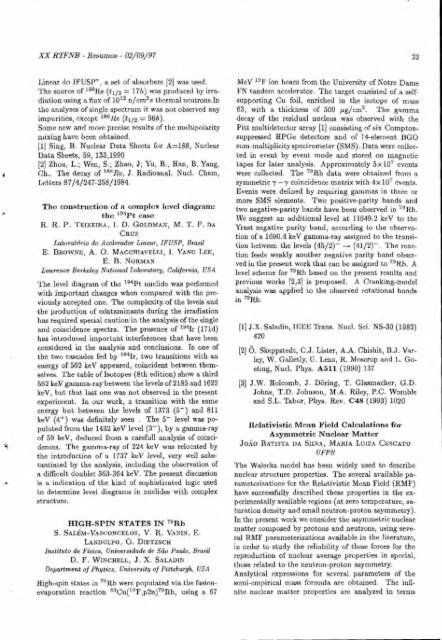REINA() DE TRABALHO SOBRE FiSICA NUCLEAR NO BRASIL
REINA() DE TRABALHO SOBRE FiSICA NUCLEAR NO BRASIL
REINA() DE TRABALHO SOBRE FiSICA NUCLEAR NO BRASIL
You also want an ePaper? Increase the reach of your titles
YUMPU automatically turns print PDFs into web optimized ePapers that Google loves.
XX RTFNB - Resumers - 02/09/97 23<br />
Linear do IF USP" , a set of absorbers [2] was used.<br />
The source of 188Re (t 1/2 = 17h) was produced by irradiation<br />
using a flux of 10 12 n/cm2s thermal neutrons.In<br />
the analyses of single spectrum it was not observed any<br />
impurities, except 186 1U (tin = 96h).<br />
Some new and more precise results of the multipolarity<br />
mixing have been obtained.<br />
Ill Sing, B. Nuclear Data Sheets for A=188, Nuclear<br />
Data Sheets, 59, 133,1990<br />
[2] Zhou, L.; Wen, S.; Zhao, I; Yu, B., Han, B. Yang,<br />
Ch.. The decay of 'Re, J. Radioanal. Nucl. Chem,<br />
Letters 87/4/247-258/1984<br />
The construction of a complex level diagram:<br />
the i"Pt case<br />
R. R. P. TtixErR.A, 1. D. GommAN, M. T. F. AA<br />
CRUZ<br />
LaboratOrio do Acelerador Linear, IFUSP, Brasil<br />
E. 13now.ro, , A. 0. MACCIGAVELLI, 1, YANG LEE,<br />
E. B. <strong>NO</strong>RMAN<br />
Lawrence Berkeley National Laboratory, California, USA<br />
The level diagram of the 194Pt nuclide was performed<br />
with important changes when compared with the previously<br />
accepted one. The complexity. of the levels and<br />
the production of contaminants during the irradiation<br />
has required special caution in the analysis of the single<br />
and coincidence spectra. The presence of 194Ir (171d)<br />
has introduced important interferences that have been<br />
considered in the analysis and conclusions. In one of<br />
the two cascades fed by 1541r, two transitions with an<br />
energy of 562 keV appeared, coincident between themselves.<br />
The table of Isotopes (8th edition) show a third<br />
562 keV gazuma-ray between the levels of 2185 and 1622<br />
keV, but that last one was not observed in the present<br />
experiment. In our work, a transition with the same<br />
energy but between the levels of 1373 (5 - ) and 811<br />
keV (9 4") was definitely seen . The 5- level was populated<br />
front the 1432 keV level (3 - ), by a gannua-ray<br />
of 59 keV, deduced from a carefull analysis of coinci-<br />
M dences. The gamma-ray of 224 keV was relocated by<br />
the introduction of a 1737 keV level, very well substantiated<br />
by the analysis, including the observation of<br />
a difficult doublet 363-364 keV. The present discussion<br />
is a indication of the kind of sophisticated logic used<br />
to determine level diagrams in nuclides with complex<br />
structure.<br />
HIGH-SPIN STATES IN 79 11.b<br />
S. SALEM-VAScoNCEWS, V. R. VANIN, E.<br />
LANDULFO, 0. DIETZSCH<br />
lnstituto de Fisica, Universidade de Sao Paulo, Brasil<br />
D. F. WINCHELL, J. X. SALADIN<br />
Department of Physics, University of Pittsburgh, USA<br />
High-spin states in 79 11b were populated via the fusion-<br />
evaporation reaction "Cu( 19 F,p2n) 79Rb, using a 67<br />
MeV 19 F ion beam from the University of Notre Dame<br />
FN tandem accelerator. The target consisted of a selfsupporting<br />
Cu foil, enriched in the isotope of mass<br />
63, with a thickness of 500 eg/cm 2. The gamma<br />
decay of the residual nucleus was observed with the<br />
Pitt multirletector array [1] consisting of six Comptonsuppressed<br />
HPGe detectors and of 14-element 13G0<br />
sum-multiplicity spectrometer (SMS). Data were collected<br />
in event by event mode and stored on magnetic<br />
tapes for later analysis. Approximately 5 x 10' events<br />
were collected. The 79 Rb data were obtained from a<br />
symmetric 7 -7 coincidence matrix with 4x 10' events_<br />
Events were defined by requiring gammas in three or<br />
more SMS elements. Two positive-parity bands and<br />
two negative-parity bands have been observed in 79 Rb.<br />
We suggest an additional level at 11649.2 keV to the<br />
Yrast negative parity band, according to the observetion<br />
of a 1690.4 keV gamma-ray assigned to the transition<br />
between the levels (95/2) - (91/2) -- . The reaction<br />
feeds weakly another negative parity hand observed<br />
in the present work that can be assigned to 79 R,b. A<br />
level scheme for 79Rb based on the present results and<br />
previous works [2,3] is proposed. A Cranking-model<br />
analysis was applied to the observed rotational bands<br />
in 791tb.<br />
[I] J.X. Saladin, IEEE rlYans. Nucl. Sci. NS-30 (1983)<br />
420<br />
[2) O. Skeppstedt, C.J. Lister, A.A. Chishit, B.J. Varley,<br />
W. Galletly, U. Lena, R. Moscrop and L. Goeting,<br />
Nucl. Phys. A511 (1990) 137<br />
[3] J.W. Holcomb, J. Doling, T. Glasmacher, G.D.<br />
Johns, T.D. Johnson, M.A. Riley, P.C. Womble<br />
and S.L. Tabor, Phys. Rev. C48 (1993) 1020<br />
Relativistic Mean Field Calculations for<br />
Asymmetric Nuclear Matter<br />
JoAo BATISTA DA SILVA, MARIA LUIZA CESCATO<br />
UFPB<br />
The Walecka model has been widely used to describe<br />
nuclear structure properties. The several available parameterizations<br />
for the Relativistic Mean Field (RMF)<br />
have successfully described these properties in the experimentally<br />
available regions (at zero temperature, saturation<br />
density and small neutron-proton asymmetry).<br />
In the present work we consider the asymmetric nuclear<br />
matter composed by protons and neutrons, using several<br />
R.MF parameterizatioos available in the literature,<br />
in order to study the reliability of these forces for the<br />
reproduction of nuclear average properties in special,<br />
those related to the neutron-proton asymmetry.<br />
Analytical expressions for several parameters of the<br />
semi-empirical mass formula are obtained. The infinite<br />
nuclear matter properties are analyzed in terms
















